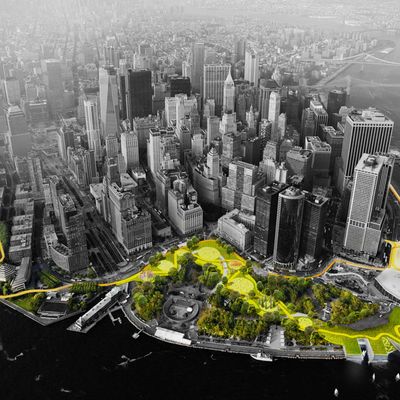
Seventeen months since Superstorm Sandy rampaged up the Eastern Seaboard, so many houses remain blasted, so many towns embittered, that the prospect of a less-soggy future seems like a receding mirage. Instead, the focus has been on shoveling out sand-choked streets, reopening businesses, replacing crippled boilers, and restoring splintered boardwalks — returning to some kind of pre-Sandy state of normality. Only that’s the mirage: Just draining everything out isn’t the same as being ready for the water next time.
That awareness rather has fueled Rebuild by Design, a competition for coastal resilience projects that offers its winners a slice of the federal government’s $4 billion disaster-recovery pie. Today, the ten finalists unveil their proposals, but it’s not a winner-take-all contest. How many of these projects will move towards reality depends largely on housing secretary Shaun Donovan, the president’s man in charge of bouncing back from natural calamities. Just as important, the competition helps elevate resilience to a national priority. The concept is only vaguely understood, but it means turning back nature’s assaults where possible, and living with them everywhere else. “If we put back what was there before, that’s a failure from the start,” says Henk Ovink, a lean, bald, hyperintense water-management expert who organized Rebuild by Design while on loan from the Dutch government. The future will not be dry.
To learn what needs protecting and what damage needs to be minimized, Ovink gave ten interdisciplinary teams — architects and engineers, but also sociologists, environmental scientists, economists, and politicians — $200,000 each and dispatched them across the New York metropolitan region, from Bridgeport, Connecticut, to the Jersey Shore. Rather than cooking up designs in their Manhattan studios and then peddling them with PowerPoint presentations, the teams attended meetings by the score. They fielded yowls of frustration, mollified skeptics, floated questions, collected worries, and pitched ideas. Communities eventually responded with enthusiasm. Hunts Point organized a cook-off for local chefs to coincide with a Rebuild by Design meeting. Asbury Park publicized the program with a parade.
The result is a series of designs by committee — not a single camel, but a whole herd of options. One team proposes ringing the coast with an archipelago of artificial barrier islands. Another suggests dropping a temporary metal barrier, like a bodega shutter, from the underbelly of the FDR Drive. A third envisions a boardwalk that meshes with the dunes rather than floating above them. Several suggest creating absorbent parks to catch and release floodwaters. None of these strategies is whimsical or wishful; all have been tried — and have worked — somewhere else. New York can benefit from a lot of wisdom tempered by calamity.
The government’s $4 billion is a drop in the rising ocean of needs, acknowledges Judith Rodin, president of the Rockefeller Foundation, which helped fund the competition. “But it’s a great drop!” And, she says, more drops are coming fast. “There’s so much money being spent on resilience now. One day we will look back on this as the time when we finally started protecting ourselves.” Besides, not spending a fortune now means spending a huger one later: A worldwide study by the World Bank concluded that the cost of rebuilding after an environmental crisis can be 50 percent higher than preventing it in the first place. Other areas — not just the Netherlands, London, and Venice, but also India, Thailand, Vietnam, and Bangladesh — have already invested in elaborate flood-resistance plans. New York is a latecomer to the world of resilience, but decisions made here now resonate across the world.
Sandy was a fluke, a cruelly useful one. Even if no similar convergence of weather and tides ever hits the New York area again, much more minor — and far more likely — events can still have appalling consequences. Take one of Ovink’s more alarming examples: The last storm spared the Hunts Point Market, but a much gentler sequel could easily knock it out of commission with a badly timed surge. Remember the gas shortages that plagued both sides of the Hudson for weeks after Sandy disrupted the supply chain? Next time, we could be spending all day on line for groceries instead of gas.
Despite the clear and present danger, the demonstrable wisdom of thinking ahead, and the cost-effectiveness of making large investments now rather than larger investments later, we still tend to wave off the rising-seas Cassandras, with their pretty drawings of chillingly expensive proposals. It’s all very well to recommend jacking up shorefront houses, but who’s going to pay for that, let alone for berms and oyster reefs and barrier islands? While the Northeast’s climate challenges are shared by much of the planet, it has a spectacularly varied coastline — which is to say, an awesome range of problems — diced into tiny townships and a jumble of competing jurisdictions. Those political divisions can have concrete effects. In 2006, the Army Corps of Engineers urged townships in the Rockaways to let it protect them with high dunes: Atlantic Beach agreed and ducked the worst of Sandy’s wrath; Long Beach refused and suffered a stunning body blow.
How can Rebuild by Design get around shortsighted parochialism? The answer, Ovink says, is the combination of regional breadth, detailed analysis, and community participation. “If we forget that we had this very complex process to get to these ten ideas, and we just build a couple and move on, then we’ve lost,” Ovink says. “If we remember that the follow-up has to be just as sustained and complex, then we win big.”






























